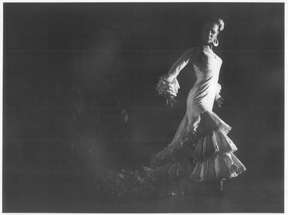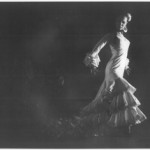by Karen Stelling
It isn’t spoken of very often in flamenco classes but this dance form requires every bit as much body training as any other dance form. Granted most flamenco dancers do not have to master a mean Cabriole Double as part of their regular technique, (landing with boots or shoes would DEFINITELY make it interesting however!) or other feats of derring-do, but flexibility, strength and correct posture are de rigueur.
Stretching, strength building and posture improvement (look in the mirror, please!) not only improve a flamenco dancer’s anatomy but improve technique, increase a dancer’s ability to sustain energy and breath for demanding sections of heel work or turns and facilitate ones ability to go from stillness to “striking”, not unlike a cobra, unleashing energy in a controlled deliberate fashion.

I have found that especially for the “brazeo” or arm movements, stretching of the entire arm, usually in a position over and behind the head, on a regular basis allows greater movement of the arms into and out of any position. Imagine that you are “strung up” by your wrists, casually blowing in the wind like laundry on a summer day…Well, okay that’s probably a little too comfy a description, because it isn’t exactly that pretty but that’s the basic idea! There was a time that I used soup cans (full, not empty!) one in each hand, to pass through all the basic arm positions. I built strength and control as well by doing this.
Many students and dancers I observe often forget that the strength needs to continue into the wrists, hands and fingers to complete the line. I firmly believe that ALL the upper body and arm energy emanates from the center of the back, like the trunk of a great tree, with the branches carrying that energy outward. It makes sense then to keep the center both strong and flexible. Doing upper and lower abdominal strengthening movements along with the side-waist muscles or obliques builds the “core.” Proper footwork takes a strong center to lift the weight out of the legs and allow them to move freely but with great control.
Of course, there remains and likely always will be, a huge emphasis on heel work and banging out great sounds, which often diminishes what the rest of the body is doing, especially the center of the body and the arms, neck and head. I’ve often commented in my classes that “any knucklehead with a decent sense of rhythm can do heel work.” In other words, it doesn’t take much to pound the floor; a few cool combination’s and you’re a super star! But that isn’t flamenco dancing. The dancing incorporates both the isolation and the joining of all your “parts!” While the arms are moving one way, the hands may move another, while the hips, legs and feet do a counter movement and the face sends out the feeling and expression! Then there is the connection to the singing and guitar…many pieces form the mosaic!
Ultimately, a flamenco dancer wants to create the most responsive body possible…so that her ideas can be fully realized in a strong and beautiful way with all the inner truth, intent and feeling apparent from the first step.






